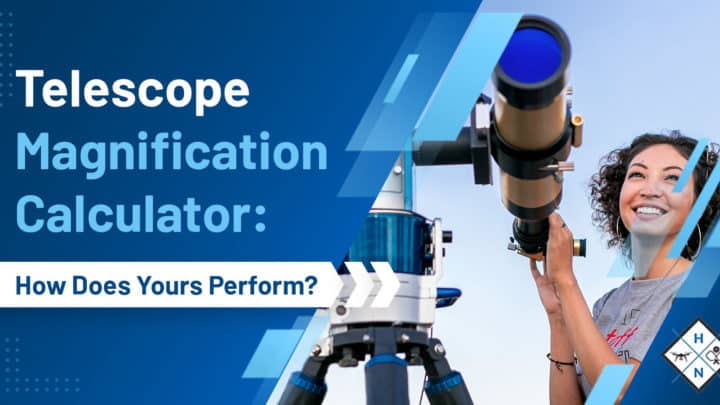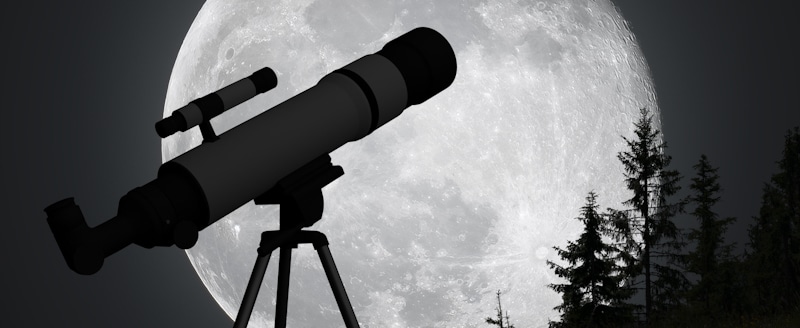A telescope's magnification describes how often an image is amplified to observe distant things in better detail. It is also known as "power" on occasion. Magnification is decided by the entire optical cycle of a system, which includes the telescope and any attachments, rather than just the telescope itself.
You have to be aware of two things to calculate a telescope's magnification; the focal length of your eyepiece and the telescope's focal length. To calculate the telescope magnification, divide the telescope's focal length by the focal length of the eyepiece you are using, which must be in mm.
You are fortunate if you would like to figure out your telescope's magnification because the calculation is fairly straightforward. The telescope and eyepiece you are using will likely decide it all the time, but other attachments like a focal extender or a Barlow lens may also be important.

Telescope Calculator
You must have seen many stunning images of planets, galaxies, and nebulae captured by both large, powerful telescopes and small, household models. Have you ever questioned how it can view far-off objects and effortlessly enlarge its images to see so much detail? The process is as follows:
An eyepiece and an objective comprise a telescope's two major components. Typically, the objective is a mirror or lens that concentrates the seen object's light beam. The eyepiece is a collection of lenses that allows you to go nearer to the image while adjusting the beam's direction.
With the help of a telescope angle of vision calculator, you can learn more about how the eyepiece impacts your experience skywatching. The objective, also called the aperture, receives light from its entire surface and filters it through the significantly smaller field of the eyepiece.
Since the telescope receives and emits the same quantity of light, the image is greatly enlarged and dramatically brightened. The most powerful telescopes can magnify this impact, which is how they can find exoplanets. You might use the high-power lens while observing to make out details obscured by low-power eyepieces.
To use this calculator correctly, you must be familiar with some fundamental information about your eyepieces and telescope. Most of these numbers are listed in the equipment handbook, on the mount or tube of your telescope, or on the eyepiece's barrel.
Telescope Calculator Inputs
- Barlow Lens: It is a lens inserted into the focusing valve to automatically lengthen the focal length of a telescope and, as a result, the magnification of the eyepieces used in conjunction with it.
- Scope Focal Ratio: The ratio of the aperture to the focal length of a lens or mirror is the scope focal ratio.
- Focal Reducer: A tool that reduces the telescope's actual focal length is known as a focus reducer.
- Eyepiece Focal Length: These lengths are almost often written in millimeters on the eyepiece device. By utilizing eyepieces with various focal lengths, the magnification of a telescope can be altered; shorter focal lengths produce larger magnifications.
- Scope Aperture: The most significant feature of a telescope is its aperture, which is the diameter of its primary lens or mirror.
- Eyepiece Apparent Field: This number is around 50 degrees for the majority of eyepieces. Inspect the eyepiece's barrel for specialty oculars.
Telescope Calculator Results
- Magnification: The degree of an object's enlargement via a telescope. It is determined by dividing the eyepiece's focal length by the telescope's focal length.
- Exit Pupil: The diameter of the light circle that strikes your eye when you gaze through the eyepiece is known as the exit pupil. Your eye will most likely not be able to perceive all of the light shining through the eyepiece if the exit pupil is greater than 7mm.
- Focal Length: The distance often measured in millimeters between a mirror or lens and the formed image is known as the focal length. The focal length of the majority of telescopes is approximately equal to the tube length.
- Approximate Limiting Magnitude of Telescope: The number indicating the darkest star you can hope to see known as the approximate limiting magnitude of the telescope. The magnitude scale indicates how dim a star is.
- True Field of View: The sphere of sky visible through a telescope or a pair of binoculars. The field of view is often larger the lower the magnification.
- Theoretical Resolving Power: The angular size of the lowest detail you can see under high magnification is known as theoretical resolving power. You can anticipate isolating the nearest double star from this information.

Telescope Eyepiece Magnification Chart
The greatest or maximum practical magnification of your telescope is one of the most important specs you should be aware of. This number will decide what accessories, such as eyepieces or Barlow lenses, are compatible with your device and the maximum amount of magnification you can achieve without receiving a hazy image.
It is not difficult to figure out the maximum useful magnification. The aperture of your telescope serves as the base variable in a simple formula you must apply. Below is the telescope eyepiece magnification chart.

Calculating Magnification
The magnification can be calculated using just two numbers: the focal length of the telescope, for example, 1200mm, and the focal length of the eyepiece, for example, 25mm. By simply dividing the numbers, we can determine the magnification; we will have 48x magnification when you divide 1200mm by 25mm.
Longer focal length telescopes will have higher magnification. The magnification provided by eyepieces having shorter focal lengths is greater. Since eyepieces are frequently referred to by their focal length, determining their focal length is simple. Therefore, the focal length of a 17mm eyepiece is 17mm.
Most eyepieces have a distinct focal length indication. A telescope's focal length can be harder to determine because the aperture is typically the most noticeable measurement. As a result, when you see a 70mm refractor or an 8-inch Dobsonian, the aperture, not the focal length, is described.
A telescope's focal length should be mentioned in the specifications if you buy one online. Since other buyers could have inquired about the focal length, you might also explore the Customer questions & answers section on Amazon. If you already own a telescope, you can frequently find the focal length there; if not, the handbook ought to have it.
There is a maximum usable magnification for each telescope. Beyond this magnification, things will still appear larger, but not better. They will start to appear considerably worse. The aperture in inches must be multiplied by 50 to determine the maximum useable magnification.
Multiply the aperture with two if you are using millimeters. For instance, the highest useful magnification for a telescope with an 8-inch aperture is 400x. A tiny refractor with a 60mm aperture could magnify objects up to 120x before the view becomes less clear.
Would you be able to effectively observe the stars at 1,000x magnification if the telescope had a massive 20-inch aperture? Most likely not. Even when utilizing a large-aperture telescope, the Earth's atmosphere will aggravate the view to fragment at very high magnifications. Details become blurry due to atmospheric turbulence, and this distortion only becomes worse as the magnification increases.
You will require a magnification of around 180 to view planets like Saturn and Jupiter; with that, you can be enabled to see the planets and their moons. A magnification of roughly 380 is required if you wish to see the planet clearly by yourself.
Final Thoughts
Although calculating magnifications is helpful, it is important to remember that larger magnifications do not necessarily mean something is superior or more effective. There are many benefits to using low magnification, including clearer views and the ability to see more of the sky. Higher magnifications might not appear as nice based on the aperture and quality of your telescope as well as the surrounding atmosphere.
Shawn Manaher loves to play with new toys and dive into new hobbies. As a serial entrepreneur, work definitely comes first but there is always room for hobbies.


